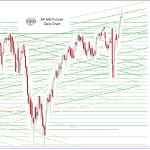It is to be expected that economists – even economists working for the same team – have different views about the likelihood of different future outcomes. Economics isn’t rocket science, and even rockets frequently land in the wrong place or explode in mid-air.
That rather hilarious characterization of the pseudoscience that is economics comes from the desk of Citi’s Chief Economist Willem Buiter and it’s apparently evidence that even if you don’t think too much of his views on “pet rocks” (gold is a 6,000 year-old bubble) or on the efficacy and/or utility of physical banknotes (ban cash), you’d be hard pressed to disagree with him when it comes to critiquing his profession. Of course we don’t want to give Buiter too much credit here because the quote shown above could simply be an attempt to stamp a caveat emptor on his latest prediction in case, like his predictions on when Greece would ultimately leave the euro, it turns out to be wrong.
As tipped by comments made at the Council of Foreign Relations in New York late last month, Buiter is out with a damning look at the global economy which he says will be dragged kicking and screaming into a recession by the turmoil in China and the unfolding chaos in EM. Here’s the call:
In the Global Economics team, however, we believe that a moderate global recession scenario has become the most likely global macroeconomic scenario for the next two years or so. To clarify further, the most likely scenario, in our view, for the next few years is that global real GDP growth at market exchange rates will decline steadily from here on and reach or fall below 2%.
More specifically, Buiter says the odds of some kind of recession (either mild or terrifying) are 55%. Not 54%, or 56% mind you, but exactly 55%, because as indicated by the introductory excerpt above, economic outcomes are very amenable to precise forecasting:
In our view, the probability of some kind of recession, moderate or severe, is therefore 55%. A global recession of some kind is our modal forecast. A moderate recession is our modal forecast if we decompose recession outcomes into moderate and severe ones and assign separate probabilities to them.
The culprit, as mentioned above, is China (where Citi says real GDP growth is actually somewhere in the neighborhood of 4%) and EMs more broadly which are suffering mightily in the face of sluggish Chinese demand, slumping commodity prices, and, most recently, the devaluation of the yuan:
Should China enter a recession – and with Russia and Brazil already in recession – we believe that many other EMs, already weakened, will follow, driven in part by the effects of China’s downturn on the demand for their exports and, for the commodity exporters, on commodity prices.
The main driver of global underperformance during the past two years has been EM weakness. No EM of any significant size is outperforming our forecasts since the beginning of the year or earlier; most are underperforming. Even the success stories, like India, central and eastern Europe, and to a certain extent Mexico, are not outperforming our forecasts. Brazil and Russia are in recession, and GDP growth there has turned negative. South Africa is in a recession, with output below potential and output growth below potential output growth. The most significant underperformer is China. For reasons explained earlier, we don’t think there is much point in forecasting official GDP growth. We therefore focus on our best guess as to the ‘true’ growth rate of real GDP, which, as noted earlier, is probably somewhere around 4% now.














Leave A Comment